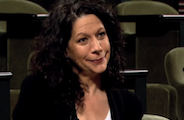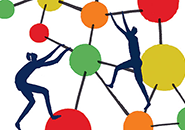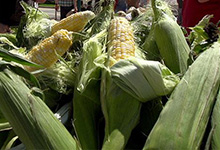Stepping off the elevator on any floor of the Broad Institute in Cambridge, Massachusetts, visitors and scientists are greeted with art: vibrant, colorful curves; thick black lines; and green and orange spirals. The installation, called Instance of a Dataset, consists of square watercolor prints assembled in patterns on a wire grid. From top to bottom, it spans seven floors.
Created by the first Broad artist-in-residence, Daniel Kohn, it is the artistic fruit of the eight years he spent discussing, disagreeing, and collaborating with scientists at the Broad Institute.
Kohn sees his collection of paintings as a metaphor for what he observed scientists doing in the lab: trying to make meaning by manipulating and assembling banks of data.
HHMI Investigator Todd Golub launched the Broad Artist-in-Residence Program after viewing a Kohn painting at the Ute Stebich Gallery, in Lenox, Massachusetts. It seemed to speak of the current state of science: some areas are known in great detail, and others remain very much a mystery. Golub and Kohn started a conversation about the similarities between art and science.
From their talks, an idea was born: Kohn would “hang out” at the Broad—initially in an unfunded, informal way—and see what art he created after interacting with scientists. After three years, Golub formalized the artist-in-residence program and converted one of the lab bays into a work space for Kohn. The artist painted alongside the scientists as they worked with test tubes and gene sequencers.
“I cleared out some lab tables, brought in some plywood, and worked in watercolors, pencil, and charcoal,” Kohn says. His usual oil paints and turpentine were too flammable for the lab.
The result of the residency was Kohn’s seven-story installation. He also designed a digital app called “Assembly Space” so users could arrange the squares into whatever patterns they desired, save and share them, and even build off others’ assemblies. When he moved the squares on his computer, he found they created a secondary order that reminded him of the way scientists work with data.
Art and science are much closer than they might at first appear, says Golub, chief scientific officer at the Broad Institute of the Massachusetts Institute of Technology and Harvard University. Rather than sitting at either end of a subjective-objective spectrum, both are, ultimately, human attempts to describe, understand, and represent the world.
“I think some of the most exciting advances in science amount to looking at an ancient problem in a new way,” Golub says. “It seems to me that’s what artists do: they reflect on what’s happening in the world through a lens that allows both artist and viewer to see an old problem from a fresh perspective.”
Kohn agrees, “They are both knowledge-generating fields, and once you look at it that way, you see they are on parallel tracks, not opposite tracks.”
| Daniel Kohn discusses his time at the Broad and the art he created during his residency. |
Since Kohn’s residency, two other artists have spent months-long residencies at the Broad, creating works inspired by their conversations with scientists. Sculptor Maskull Lasserre is there now.
From the artists, Golub has learned to keep reinventing his approach as science evolves. He’s also reminded that what scientists think are foundational truths are often just assumptions worth revisiting. “The point is for artists and scientists to provoke each other in new directions,” Golub says.



















